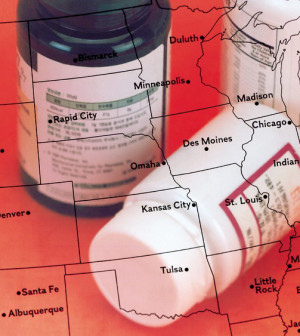- Navigating Your Midlife Crisis: Embracing New Possibilities
- City Raccoons Showing Signs of Domestication
- Mapping the Exposome: Science Broadens Focus to Environmental Disease Triggers
- One Week Less on Social Media Linked to Better Mental Health
- Your Brain Changes in Stages as You Age, Study Finds
- Some Suicide Victims Show No Typical Warning Signs, Study Finds
- ByHeart Formula Faces Lawsuits After Babies Sickened With Botulism
- Switch to Vegan Diet Could Cut Your Greenhouse Gas Emissions in Half
- Regular Bedtime Does Wonders for Blood Pressure
- Dining Alone Could Mean Worse Nutrition for Seniors
Needed: An ‘Action Plan’ for Kids Prone to Severe Allergic Reactions

When kids are at risk of severe allergic reactions, all their caregivers should have a written action plan and epinephrine auto-injectors readily available, according to new reports from the American Academy of Pediatrics.
The reports include a new “universal” action plan for doctors to give parents, to help ensure they’re ready to manage a life-threatening reaction called anaphylaxis.
Anaphylaxis is a sudden, severe allergic reaction that affects multiple organs in the body. The symptoms include swelling of the throat, lips and tongue; trouble breathing and swallowing; chest tightness; vomiting, and hives or skin rash.
It’s an emergency and needs to be quickly treated with an auto-injection of epinephrine, said Dr. Scott Sicherer. He’s a professor of pediatrics, allergy and immunology at the Icahn School of Medicine at Mount Sinai in New York City.
Sicherer co-authored the new AAP reports. The recommendations were published Feb. 13 in the AAP’s journal Pediatrics.
One report stresses that epinephrine auto-injectors — not antihistamines — are the “first line” treatment for anaphylaxis.
The second report highlights the importance of families having written action plans, and includes a two-page form doctors can give to parents.
“This certainly isn’t the first written action plan for anaphylaxis,” Sicherer said.
But right now, doctors use various forms that differ somewhat from each other, Sicherer explained. So the AAP devised a “comprehensive” plan that doctors can easily access online.
The bottom line for parents, Sicherer said, is this: If your child is at risk of anaphylaxis, you should have some written plan from your doctor.
Parents will need to talk with their pediatrician or allergist to know whether their child is at risk, according to Sicherer.
But the most common causes of anaphylaxis include allergies to certain foods, such peanuts and shellfish, as well as allergies to insect stings, certain medications or latex.
The AAP action plan provides a list of anaphylaxis symptoms and milder allergy symptoms, and simple instructions on how to respond to each.
If parents think it’s anaphylaxis — but aren’t 100 percent sure — they should still use their child’s auto-injector immediately and call 911.
“Epinephrine is safe and very effective,” said Dr. J. Andrew Bird, a pediatric allergist at University of Texas Southwestern Medical Center and Children’s Health in Dallas.
“I’d rather parents err on the side of using it, than not using it,” said Bird, who wasn’t involved in the AAP reports.
According to Sicherer, parents should give copies of their action plan to all of their child’s caregivers — and to their school, camp or other settings where kids might be exposed to their allergy trigger.
Bird noted that many schools have their own written forms they want parents to complete.
What’s important, he said, is that everyone is aware of the child’s allergy and knows how to recognize and respond to signs of anaphylaxis.
The written plan is not enough on its own, Sicherer stressed.
For one, he said, parents have to know how to prevent severe allergic reactions — by minimizing their child’s exposure to the culprit allergen.
And, Sicherer said, they should be sure they know how to use their child’s auto-injector, so they’re not scrambling to figure it out in an emergency.
Parents should keep two doses of epinephrine on hand at all times, Bird said.
The best-known brand of auto-injector, EpiPen, costs around $600 or more for a two-pack.
But, Bird noted, there are other auto-injectors out there.
That includes a new generic version of the Adrenaclick device that CVS Pharmacy prices at $110 for a two-pack. With the manufacturers’ coupons, the price can be cut to $10.
Whatever device parents choose, Bird said, they should be sure they learn the specific instructions for how to use it.
Anaphylaxis is not rare. It’s been estimated that at least 1 in 50 Americans — and possibly as many as 1 in 20 — has suffered an anaphylactic reaction, according to Asthma and Allergy Foundation of America.
More information
The American Academy of Allergy, Asthma & Immunology has more on anaphylaxis.
Source: HealthDay
Copyright © 2025 HealthDay. All rights reserved.










